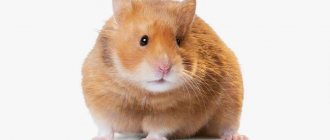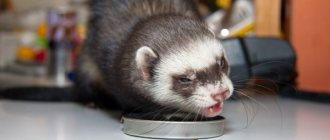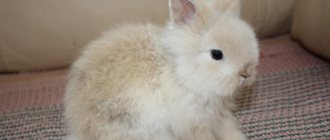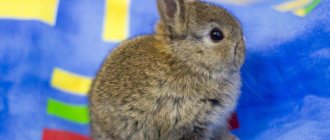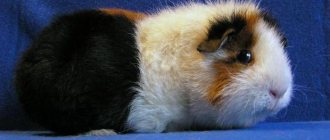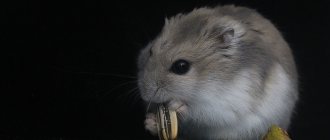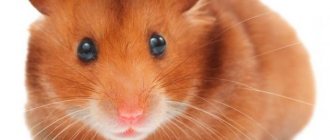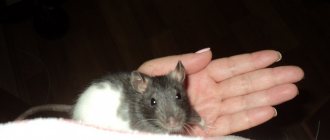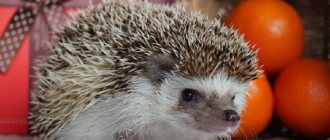After birth, children get confused: they scream, squeal, look for food, for their mother. Newborns already have fur, long whiskers and a bristly tail, which sets them apart from other rodent puppies. Sand flies, rats and hamsters are born hairless.
The fur of newborns is wet, so measures must be taken to dry the animals. Otherwise, they may catch a cold, get sick and die.
Once the young are dry, they crawl under the female's belly, where they feel safe, eat and sleep. After 2-3 hours, you can begin the countdown: you will need to wash the young and mother in warm soapy water, get rid of the consequences of childbirth, throw away the dead young, weigh the living one and determine its gender. This must be documented electronically or in writing (as appropriate).
For water treatments, use only laundry soap, as toilet soap leaves an odor on the newborn's coat, and if the mother smells something else, she may refuse to feed the chinchilla.
Puppies immediately see the world around them because they are born with vision; cases of blind puppies are rare. Most often, closed eyes are caused by something getting into them: hair, fluff. If this situation occurs, the eyes should be washed with a damp cotton swab. Eyes should be washed with infusion of chamomile and black tea without additives.
After 4-5 hours, you need to check the puppy's anus. The owner should notice that the puppy has gone to the toilet, as evidenced by the remains of feces on the fur. This is a good sign and indicates intestinal motility. Otherwise, rectal prolapse and inflammation of the anus will occur.
It is impossible to solve the problem alone without the appropriate qualifications. If the intestines are displaced, vital organs can be easily damaged, and if the inflammation is relieved, the disease can develop into a more severe form. The child should be immediately taken to an experienced specialist; only a veterinarian can help the newborn.
Be sure to monitor your weight and record data. A newborn weighs about 50 grams. At first you will have to weigh the children every day. They will initially lose a few grams, but will quickly return to gaining weight over the next 24 hours.
If the female has problems with lactation, the milk is too thick, the young may continue to lose weight, which will be noticeable when weighed daily. In this case, it will be necessary to switch to artificial feeding: regular baby milk will do, which should be independently regulated with a pipette.
Hard breast milk returns to normal after 3 days. You can try to speed up this process by feeding dry nettle to your chinchilla. Some owners use the medicine Apilak when the leaves do not have the desired effect.
It is much worse when there is no milk at all, then you have to feed the offspring by hand, and they need food every 2 hours after birth. Later they will eat less frequently, but for the first two weeks you will have to take time off to care for your newborn.
For the first time, a chinchilla manages to give birth to only 1-2 young ones, while a more experienced female gives birth to 3-6 young ones. Naturally, the animal has 2 active nipples, although there are cases when 4 nipples are functioning.
For this reason, when there are relatively many young animals in the litter, it is necessary to alternately feed them independently of each other. Otherwise, the strong will beat the weak and keep them away from their mother's breast.
For small animals, prepare a separate box of sawdust as bedding. Be sure to provide a table lamp for the offspring of four-legged animals. It is worth equipping the container with a cardboard box in which the puppies will hide from the intrusive light of the lantern - this will help avoid overheating.
No one is allowed to visit babies before they are one month old, as rodents at this age are susceptible to infectious diseases, and small animals can easily get injured. Infants should be cared for and weighed by only one person, and only one person should perform pre-hygiene procedures.
Recommendations for setting up a cage for cubs
Active puppies can often get hurt, so dangerous situations should be avoided. The chinchilla and offspring should be moved to a hamster cage with bars no more than 1 cm apart, or the mother's house should be lined with a fine mesh cage. All accessories must be removed from the cage; it is important to exclude any possibility of the young animals escaping outside.
Feeders and drinkers should be placed at low heights so that infants have access to food and water. It is important to teach them to feed themselves from an early age. If there is a place for artificial feeding, it is necessary to install an additional milk absorber.
Clean the cage daily: change the bedding, clean and update the feeders and drinkers. To prevent intestinal diseases, it is recommended to wipe the cage floor with salicylic alcohol.
Chinchilla pregnancy. Peculiarities
If your pet is 7 months old, weighs at least 500 grams, and the male is 6 months old, then mating is possible. In order to correctly and timely help a pregnant chinchilla, it is necessary to keep records of the mating date, heat and actual mating of the animals. Animals' weight should also be monitored throughout the adoption and pregnancy period. This monitoring will help you better determine your stop date. Gestation in chinchillas usually lasts from 105 to 125 days.
Chinchilla after childbirth: possible complications
While watching chinchillas give birth, their owners had to deal with similar complications:
- Long labor. This may be due to illnesses suffered during pregnancy or malnutrition. These abnormalities usually occur in young females or are the result of developmental abnormalities. Animals can be helped by gently massaging the abdominal cavity. After giving birth, the chinchilla recovers quickly.
- Puppy injuries. In the first case, the newborn cannot free himself from the foil while the mother gives birth to another puppy. You need to tear the foil with your fingers and clean the baby's muzzle with an ear stick. In the second case, the woman damages the fetus with her teeth, pulling it out. It is necessary to apply medicinal ointment to the wounds.
- Abnormal output of the puppy. If the fetus comes out backwards, there is a risk that it will get stuck and the female will die. Hold the puppy's paws, hold the mother's tummy, and gently pull him out.
- Milk fever. The disease is associated with calcium deficiency, manifested in the form of spasms throughout the body. The animal should be administered 10% calcium gluconate in 0.3 ml, diluted in 1 ml of saline.
Sometimes problems arise and human assistance is required, for example in the following cases:
- Three or four chinchillas fight among themselves for their mother's nipples.
- The female never produces (disappears) milk
- Female chinchilla behaves aggressively towards offspring
Let's look at the cases in more detail.
Chinchillas fight over female nipples
The female has four out of six working nipples. They are located on the stomach on the sides closer to the armpits and hind legs of the animal. If the female previously had only one baby, then the next litter will receive only one “developed” nipple. When three or four babies are born, competition for nipples arises. Chinchillas fight with each other for a place under the female. Cute furry creatures can be fierce when fighting for food, biting and injuring each other. The weakest among them suffer the most. Check babies for injuries. The solution to the problem is to place chinchillas with the female one at a time. And in the first days you will still need to feed them artificially.
The female has lost her milk
Five or more days pass and the milk still does not appear. If the female does not produce milk for more than 10 days, most likely there will be none. The chinchilla will have to be fed artificially or placed with another lactating female.
Mother chinchilla is aggressive towards babies
Sometimes a mother chinchilla attacks her newly born children. The reasons for aggression are not completely clear to us; they are of a psychological or physiological nature. Perhaps the psyche of the female who gave birth is influenced by stress from a difficult birth, the smell of a foreign female accidentally sticking to the newborns, or an acute reaction of the body to a lack of nutrients. Without going into details, only one thing is clear - immediately remove the chinchillas and decide what to do next. There is advice that the female should be given warm beer and this will relieve stress. Or that the female needs to be placed again with the male to soften her temper. We tried, but these methods did not work. At best, the female remained indifferent to the children, and at worst, she attacked them again. An aggressive female bites and inflicts wounds on chinchillas, even fatal ones. There is no point in risking the lives of the babies and wasting time “correcting” the female. The cubs should be fed artificially or placed with another lactating female.
We have encountered similar cases in our nursery. One female immediately after giving birth attacked two of her babies. We placed the chinchillas in temporary housing. They put a heating pad in a cardboard box and covered it with a towel to keep it from getting too hot. The heating pad worked around the clock. The babies lived in the box for 2 weeks on artificial feeding. Then we were lucky, another female gave birth to one baby. We successfully placed abandoned chinchillas with a female who gave birth. For some time, all three babies had to be artificially fed. All three animals survived and grew up safely.
So, problems that arise can be solved in two ways:
- Artificial feeding of a baby chinchilla
- Placing chinchillas with another lactating female
Newborns and small chinchillas
Newborn chinchillas are cared for by a female chinchilla. The owner’s task is to provide proper conditions for the newborn chinchilla and provide the mother with adequate nutrition.
In addition, it is necessary to take care of a balanced diet during pregnancy so that the intrauterine nutrition of infants is sufficient; the health and development of puppies depends on this. The content of the article
Pregnancy lasts 106-114 days. As labor approaches, female activity decreases and appetite worsens. Try to keep the animal away from loud noises, flashes of light and provide a calm environment for the expectant mother. A woman under stress may have a miscarriage or premature birth. Premature puppies often die.
Prepare a place for newborn chinchillas:
- change bedding, preferably using dry, fresh, fine hay;
- Collect the female, put her in the nest;
- cover the nest with a cloth.
Birth occurs at any time of the day, but more often at night. The female licks the chicks, places them in the nest and feeds them. It is necessary to provide a comfortable climate for the chinchillas and, if necessary, additionally insulate the nest. Chinchillas are born fully formed:
- teeth;
- with eyes open;
- covered with wool.
In the first few hours after birth, you just need to make sure you have enough clean water for the mother - she will be very thirsty.
Also read: how to make a display case in a chinchilla cage. How to make a chinchilla cage with your own hands at home.
How does childbirth occur?
In most cases, chinchillas give birth in the morning. A healthy rodent does not pay attention to others, being completely absorbed in the upcoming event. The birth of chinchillas occurs after the female assumes a sitting position and begins to push. When the fruits are positioned correctly, they come out at intervals of 5-7 minutes. During this time, the mother manages to remove the film from the puppy and clean it of mucus. After the last fruit comes the afterbirth. The animal immediately eats it.
After giving birth, the chinchilla is weakened and is unable to move for some time. To restore strength and replenish energy balance, you need to give her a few raisins, calcium powder and plenty of warm drinks.
Chinchilla gave birth, what to do in the first few hours? The room must be maintained at a constant temperature within 19-22 °C. You can use a heater, or, if there is no electricity, an alcohol burner. Sawdust prepared in advance could become wet and saturated with mucus and blood. They should be replaced gradually, after the female drags the newborns to a dry place.
Feeding recommendations
It is not enough to know what you can and cannot feed your chinchillas. Proper feeding also means following a feeding schedule, keeping feeders and water bowls clean, and understanding your chinchilla's digestive system.
The first and most important rule is that there should always be enough hay and water in the cage for drinking. Feeders and drinkers must be clean. To do this, they should be disinfected regularly (at least twice a week) with boiling water.
Wooden feeders should not be used as they absorb odors and are a source of mold and mildew. Preference should be given to ceramic feeders that attach well to the cage and are easy to clean.
Chlorhexidine can be used as a disinfectant in the cage - it kills germs well and has no odor, but it is better not to use it for watering and feeding.
Some breeders also use regular laundry soap as a disinfectant. Water troughs, feeders and the cage can also be cleaned with alcohol. Keeping the cage clean is also necessary because sometimes the animal prefers to eat in the rest area or even in the house. Many owners have noticed how a chinchilla takes a piece of food and runs to the shelter.
It is also important to ensure that all products are fresh, clean, free from dust, rot and mold. It is recommended that you only buy prepared food from a reputable pet store.
All succulent food, as well as lettuce or spinach, should be thoroughly washed before being given to your pet. Branches and bark of trees offered to your pet should be well dried and free of traces of insects.
Vegetables and fruits for chinchillas should always be washed and cut into small pieces.
The animal should be fed at the same time and all residues should be removed from the feeder the next day. It is recommended to give rough food in the evening, and juicy food in the morning. If your chinchilla doesn't want to eat, change the food. The first reason for poor appetite is monotonous food.
New foods should be introduced gradually and in small portions. If you are unsure whether a particular food is suitable for your chinchilla, it is best to avoid it completely and add something that your chinchilla has already tried and enjoys eating.
Feeding a pregnant chinchilla
The feeding of a female expecting cubs is not much different from the diet of other individuals. First of all, experts recommend increasing the protein content. The female may begin to drink more and eat a little more food. But you should not feed the expectant mother, this can lead to obesity. It is important that the rodent’s menu includes the following products:
- Sprouted grain – it has a high concentration of vitamin E, which is responsible for the reproductive function of the body. A lack of this vitamin is quite capable of leading to infertility or pathologies in the development of cubs. Wheat, barley and oats are best suited for germination.
- Herbs such as nettle, alfalfa, vetch, flax seeds, calendula flowers, rose hips, oatmeal, strawberry leaves - they all improve lactation.
- Food of animal origin (you can give the female milk pellets as an additional source of protein; they are available in pet stores).
- Calcium – 1/4 of a calcium gluconate tablet once a day – if calcium is not added to the food, the cubs will receive it from the mother’s teeth and bones, which will have a bad effect on the health of the female.
- 2 - 3 weeks before giving birth, an apple is introduced into the diet - 1/8 of the fruit once a day.
- It is recommended to give the female 2–3 balls of beebread (a waste product of bees) daily.
Herbs such as thyme, lemon balm and mint should be excluded from the diet of a pregnant or lactating female.
Feeding newborn and older puppies
Young chinchillas may feed exclusively on their mother's milk or require additional milk. This depends on the number of puppies in the litter and milk production. If newborns are constantly squealing and have stopped gaining weight, start supplemental feeding. Any baby formula will work well for this purpose: It's very convenient to feed babies a ready-made liquid formula, you can't go wrong with diluting the dry powder.
You will often see advice for feeding your chinchillas diluted evaporated milk or pure cow's milk. Please note that these animals have very delicate digestive tracts.
Condensed milk, even diluted, contains a large amount of sugar and fat, which negatively affects the liver, and pure cow's milk contains a large amount of protein, which negatively affects the kidneys. There is no need to skimp on the health of small pets.
Feeding should begin with 1 ml of formula, increasing the volume as the child grows older. It is most convenient to administer the mixture from a syringe, wrapping the animal in a towel. Feeding is required every 2-3 hours, including at night.
If the mother does not breastfeed after giving birth, continue to try to breastfeed naturally. Milk may appear on the third day after birth. Sometimes pick up your chinchilla, gently massage the nipples and try to suck out a few drops.
At the end of the first week of life, small rodents begin to try adult food; it is best to immediately add food mixture for individuals under 12 months of age. In infancy, animals are not limited in nutrition. Small animals often continue to drink their mother's milk until they are almost two months old, at which point they are separated from the adults.
Do they eat berries and nuts?
Chinchillas are incredible gourmets, especially when it comes to nuts and berries. The key problem with these products is that they need to be given in strictly limited quantities. Some berries – no more than once a week. Nuts contain a huge amount of fat, which is harmful to any animal, especially chinchillas.
Particular attention should be paid to the amount of nuts in the diet such as almonds, peanuts, hazelnuts, and walnuts. They should serve as additional food for the animal and provide it with the necessary proteins and fats, but should not form the main diet of the animal
In total, this should be no more than 2 nuts per week.
The same applies to the inclusion of berries in the animal’s diet. As a rule, they are used as sweets or when the animal’s body lacks some vitamins. In this case, you can give the animal 1-2 berries per week (rose hips or viburnum). This point does not apply to berries such as cherries and cherries, which have too high an acidity level for chinchillas and can only be consumed in dried form. Famous sweet berries for chinchillas are figs, raspberries, and strawberries.
Prohibited Products
Among the fruits prohibited for consumption is persimmon. This healthy fruit is rich in iodine, which is contraindicated for animals. In addition to iodine, persimmon contains a lot of sugar and astringents, which leads to constipation.
It is also not recommended to feed beets to chinchillas.
The root vegetable is healthy, but has a laxative effect. In rare cases, small pieces of beets can be given for constipation. Any type of cabbage leads to strong gas.
Chinchillas love to eat tea rose petals - they have a pleasant taste and attractive aroma. There is no danger if you grow flowers in your own garden, but do not use store-bought flowers. They contain many pesticides and chemicals that can cause serious poisoning.
When removing tree branches for the winter, it is worth remembering which species are dangerous and not suitable for feeding.
Branches that should not be pruned:
- Apricot,
- White acacia,
- Beech,
- Aspen maple,
- Regular limegrass
- Cedar,
- Chestnut,
- Branches of any type of citrus fruit,
- Cypress,
- elderberry fruit,
- Cherries,
- Cherries,
- Branches of any coniferous species,
- Holly,
- Hydrangeas,
- Juniper,
- Common maple,
- Myrtle,
- Oleander,
- Plums.
Oak bark and twigs should only be given to animals suffering from diarrhea. In healthy animals they cause severe constipation.
The branches of stone fruit trees (cherry, cherry, plum, etc.) are dangerous because they contain a dangerous cyanide compound, which breaks down in the chinchilla's body to form hydrocyanic acid. If you feed a chinchilla with such twigs, it can cause not only severe poisoning, but also the rapid death of the animal.
Species diversity
There are quite a few breeds of chinchillas and a variety of colors. To breed chinchillas at home, you need to choose only valuable colors, which cost from 8,000 rubles per child.
To choose the right male, you need to know the name of your breed. The male's coloration should roughly match the male's to ensure you get the right coloration in the cubs.
The main breeds of chinchillas:
- Albino;
- White recessive;
- White dominant;
- Pink and white;
- Beige dominant;
- Agouti;
- Foggy;
- Motley, etc.
To know which species can be crossed and which cannot, look at the genetic table.
Puppy development
The growth rate of small rodents depends on the characteristics of care and reproduction. Usually animals grow quite quickly, already at the age of one month their size triples.
After two months, the young person should be placed in a separate cage, and males and females should be kept separately, since pregnancy can occur even at the age of three months. This is undesirable for a young animal.
Pets should continue to be weighed 2-3 times per week after relocation. If you notice that one or more babies are developing slowly, pay attention to how the animals feed and behave. Perhaps their older brothers are preventing them from reaching the female's nipple or pushing them away from the feeder.
The chinchillas surrounding the baby with attention and care create favorable conditions for their development, and the small, clumsy rodents will grow into affectionate, healthy pets.
Care immediately after birth
Helping the doe and the calves that greet her is usually not necessary. Help may only be needed if the birth is difficult, but in this case it is better to call an emergency veterinarian. It is necessary to ensure that the mother, especially the young one, does not accidentally move the young ones, and that they are all born. After an hour, check whether all the puppies are dry; if for some reason they are not dry, then they should be carefully wiped and dried under a lamp.
A chinchilla puppy in the arms of its owner.
After a few hours, the child should be examined and weighed. All observations should be recorded in a health diary: weight should be added daily (initially 1-2 g, and from the fifth day - at least 4-6 g).
Before handling calves, hands should be washed with homemade or antibacterial unscented soap. A toilet with perfume is not suitable - due to the strong smell, the mother cannot pick up the babies. Babies should be handled very carefully as they are very delicate and easily injured.
After 4-5 hours, the calves are examined again, paying special attention to the condition of the anus: feces should come out of it. If this is not the case, then it is possible that the puppy's intestines or excretory system are not working properly.
You must call the vet or the puppy will die. You should also examine the eyes: they are already open from birth, but until a certain time puppies squint, leaving only narrow spaces between the eyelids.
If this condition persists for 5 hours, this means that an inflammatory process is occurring. The eyes are carefully washed with cold tea using a cotton ball.
Is it profitable to breed chinchillas for sale: reviews from owners, diagram
Maxim, Vladivostok, 38 years old
The idea of breeding chinchillas for sale came to us spontaneously. Before this, there was just a couple living with us, and the female was pregnant. We bought the necessary cages for them (at first we lived together), various food and other supplies. Initially, together with the animals, it cost us 25 thousand rubles. The first birth went well - 2 puppies. We also spent on a cage and food. During subsequent births, the female decided to eat her puppies. Next time we watched all night. After about 1.5 years, in the end we already had 3 females with 2-3 litters. It was necessary to install a split system because the livestock had grown and they did not like the heat. We did this in the apartment. But trouble struck again - the cubs began to get sick, and the slightest changes in food led to dulling of the fur. Vitamin supplements corrected the situation a little. But expenses began to rise, and there was no income yet. My wife and I got into debt. In total, we spent more than 600 thousand on their maintenance. We were able to sell all the chinchilla puppies, and then decided to sell the adults as well. But at absolutely not the price we expected. And we earned as much as 156 thousand rubles from them! Draw your own conclusions.
Approximate diagram
Victoria, Ekaterinburg, 31 years old
I have had chinchillas for over 5 years. I breed them not so much for money, I just like these animals. We have a private house - there is a lot of space, my husband made 2 large display cases himself. For the first 3 years, selling puppies did not bring much profit, but we did not strive for this. Then we kept another pair for ourselves, space allowed. But we gave them a whole room. There were complications, but my trusted veterinarian could give advice over the phone and even come at night. The second firstborn gave birth for a very long time. I can’t give exact numbers, but on average we spent about 20 thousand on them. This includes all materials. But, I repeat, we did a lot on our own - significant savings on these same cells. And now, after 5 years, in total we earned a little more than 30 thousand from the sale. Basically, we sold it to maintain the house at an affordable price. Therefore, my conclusion is that you can make money on them if you have a lot of space and this is not your specific goal. Gradually, gaining new knowledge, you can expand your production.
Placing small chinchillas
It is better to provide the mother and baby with a separate cage; an ordinary hamster cage is sufficient. The main condition is to install fine wires so that the young cannot crawl between them; you can additionally wrap the box with a fine mesh.
Inside, the female usually makes a nest herself, but it is recommended to install a special house for her, which in the first 3 days turns the entrance hole upward so that the puppies crawling around the house cannot escape.
The chin cage for infants should not contain traumatic objects, unnecessary crossbars or shelves from which there is a risk of falling and injury.
Feeders and drinkers should be located at a low height on rods in order to accustom newborn chinchillas to eating. The cage should be washed daily and the floor wiped with a manganese solution to prevent the spread of infection.
Get rid of the nest if the female begins to hide in it from her offspring and will not feed them. Perhaps she is stressed after childbirth or lacks maternal instinct. If she is constantly showing aggression, it is better to put her aside and bottle feed the babies. In this case, an infrared lamp is used for heating.
It is recommended that children are finally separated from their parents at two months of age. We must be prepared for the fact that at first the cub will whine and refuse to eat, but after a few days the stress will pass. The main indicator is weight; otsat was allowed to people weighing 200 grams. If teenagers are overstimulated around their mother, they will begin to disrupt their hormonal balance.
CHINCLUB.RU - CHINCICLOPEDIA
ARTIFICIAL FEEDING AND CARE OF CHINCHILLATES
In normal situations, a chinchilla copes
with feeding and caring for the offspring on its own, but there are cases when it is impossible to do without
the intervention of the owner
. Let's look at some of them in more detail.
Female chinchilla
brings litter twice a year.
The average number of puppies is one or two. But sometimes many more chinchillas are born - three, four, and sometimes five or seven. And then the chinchilla cannot always provide everyone with enough milk. Hungry kids will start serious fights and injure each other with their teeth. The bite of a newborn chinchilla
is very painful even for a person, but for another baby it is extremely dangerous: an injury to the muzzle, eye, nose or lip can become a serious obstacle to nutrition and, accordingly, the normal development of the chinchilla.
To understand whether your babies are getting enough milk, you need to watch them and monitor their weight dynamics
.
Loss or static weight, fights, attacks on mother and brothers are a signal that there is still not enough food. As a rule, within three to five days after birth, the female chinchilla
does not yet begin to produce milk; instead, babies receive
colostrum
, a substance high in proteins, immunoglobulins and antitoxins to protect newborns.
Therefore, usually the first few days the weight of puppies does not increase. Article on the topic: How to euthanize a rat at home and in the clinic
On the fourth or fifth day, milk, as a rule, appears, and chinchillas begin to quickly gain weight. In this case, no help from the owner is required. But if weight loss in babies continues, then it is necessary to start feeding chinchillas
manually.
Babies are fed milk until about 8-10 weeks. Lactose-free milk formulas for children from 0 months, which can be bought in pharmacies or stores, are suitable for artificial feeding. There are two types of feeding mixtures: ready-made and in powder form. Ready-made mixtures must be consumed quickly, but powdered ones can be stored in the refrigerator for several months. Chinchilla breeders for feeding newborn chinchillas
They successfully use Agusha baby cream, Malyshok formula for newborns, and Kitty Milk powdered milk for kittens.
Never offer your babies expired formula, it is dangerous for their life. For feeding, you will need a regular 2 ml plastic syringe without a needle. It is not recommended to use a pipette; a chinchilla can chew through thin glass and swallow a piece. Powder mixtures must be diluted according to instructions in warm water. Do not use tap water, only clean, filtered water. Be sure to dilute a new mixture at each feeding; when prepared, it can be stored for no more than an hour. After each meal, you need to thoroughly rinse all containers and the syringe, and then it is advisable to pour boiling water over them.
Be prepared for the fact that your chinchilla will not immediately actively eat the food you offer. At first, the puppy may struggle, turn its face away and try to run away from you. Over time, he will taste the food offered and will joyfully and impatiently greet you and ask for milk. During feeding, you should not turn your chinchilla over, rush or feed a large amount of food at one time. It is much more effective and more correct to offer the baby reinforcement more often (at first about once every half hour to an hour, and after a few weeks - once every two hours).
Article on the topic: Stroke in a rat: symptoms and treatment
After feeding, gently massage your puppy's belly in a clockwise circular motion, then let him run around for a bit. This stimulates intestinal function
.
It is necessary to carefully monitor your baby's stool. Artificial people quite often have a problem with bloating
, which is extremely dangerous for their life. In this case, it is necessary to give drugs containing the active substance simethicone, for example, Sub-Simplex or Espumisan. Simethicone causes the destruction of bubbles in the stomach and intestines. You may also need to add enzymes to your food to stop the bloating.
Be sure to weigh your babies at the same time every day to assess progress in weight gain. In the first stages of chinchilla
should add at least 1-2 g per day. If the weight falls or stays at the same level for a long time, it is necessary to increase the frequency of feeding or the fat content of the milk.
If your babies are left without a mother, then it is extremely important to keep them warm. Little chinchillas
They cannot independently maintain the desired body temperature and warm themselves using the female’s heat. Therefore, be sure to put a plastic bottle with warm water in the display case and wrap it in a towel. The chinchillas will bask and sleep next to her. The water in the bottle must be renewed as it cools.
About 2-3 weeks after birth, puppies begin to become interested in adult food. You can offer them a special baby food for chinchillas
and high-quality hay, and hang the milk in a drinking bowl for a while.
Be sure to show your little ones how to use the sippy cup by touching the spout when the little ones are nearby.
In the second week, chinchillas can be offered a bath with sand - their instinct will work automatically, sooner or later they will begin to clean their fur in the sand with great pleasure.
Article on the topic: What to do if a turtle sneezes?
If all the basic tips and recommendations have been followed, then by two months the puppy will weigh at least 200 grams. Such babies should be given to a new home no earlier than three months, weighing 250-300 grams.
Author of the article - valkeryne
. Full or partial copying and posting of information from the site is prohibited
.
Readiness for mating (estrus)
Like many animals, female chinchillas have a period of heat (hunting) when they are ready to copulate and, moreover, want it. On average, the heat lasts from 2 to 5 days, after which the mating process may fail.
It's easy to tell if a chinchilla is hunting. Her behavior is very exploratory, she begins to throw everything around and create complete chaos in her cage. Along with active behavior, the female eats very little or nothing at all.
The second sign is external signs. The genitals become swollen and bright pink.
Reproduction
When breeding chinchillas at home, you need to take into account that the animal is nocturnal and they like to mate at night. It is very difficult to catch them during the process. Mating lasts a few seconds, so you can skip it if you just go to the kitchen for a drink of water.
In order for mating to be successful, it is necessary to place the male only during the female’s hunting period, otherwise the female may refuse her lover.
Sometimes, to make sure that mating was successful, you need to look into the cage. Usually, after mating, there are scraps of fur lying around in the cage, which are not observed during normal times.
After mating, it is necessary to place the female in another cage and monitor whether it is replenished or not. If a chinchilla becomes pregnant, she usually gains 30-50 in the first two weeks. In this case, you need to feed with regular food and standard portions, otherwise it may turn out that you simply overfed the female.
When you are convinced that the female is pregnant, you need to make her diet more varied. In the diet you need to increase the amount of vitamins and microelements that are necessary for the proper growth of the cubs. We have a separate article about the diet of pregnant chinchillas.
Until what age are chinchillas considered teenagers?
There are several age periods in the life cycle of furry pets:
- Newborns - from birth to a week;
- Young - one, two and three weeks;
- Dot;
- sexually mature six-month-old children;
- adults - 12 months.
They reach full strength and maximum weight at one year of age and are then considered adults. Before this, they are considered minors, although they can begin mating as early as 6 months of age. However, this is not desirable and females and males are kept in separate cages.
Adult puppies should have a normal weight of 100 g, a monthly weight of 180 g, and their height should be three times the body length of the newborn. Six-month-old children should already weigh 400-450 g, and nine-month-olds - 500-600 g. At the age of one year, chinchillas shed their first fur, replacing baby fluff with a thick velvety coat, and move into the adult category.
Three month old teenage chinchillas
How quickly and to what age do chinchillas grow?
Chinchilla babies grow quite quickly. With an average starting weight of 55 grams, by the end of the second week of life, healthy puppies weigh an average of 100 grams. In the first three days of life, newborns are fed on colostrum, and from the 3-5th day on breast milk.
Unlike other mammals, baby chinchillas begin to eat hay already from the 3rd day, by the 5th-7th day they try adult food, and the interest and ability to drink from the drinker’s nipple appears in 2-week-old babies.
By 3 weeks of life, fluffy puppies are actively fed breast milk or artificial formula. Four weeks after the birth of the child, the female's lactation decreases to a minimum, but if the young are kept with their parents, they can be fed with a small amount of breast milk until the age of three months.
A one-month-old puppy is three times larger than a newborn, its weight is actively growing and reaches 160-180 grams. Young chinchillas already eat adult food and reach a weight of 550-650 grams at 9 months. Depending on the breed, when animals are kept in pairs, more active muscle development and weight gain occur. Chinchillas grow for up to 18 months, and after a year they develop into an adult form.
In one year, this adorable little creature sheds its soft baby fur, and a few months later, it grows its famous thick, velvety coat.
Diet example
A person will not like to eat the same food every day. Not everyone can eat buckwheat for a week, for example. So why subject your pet to the same torment? A chinchilla needs a complete and varied diet. It will not only be tasty for the animal, but also healthy. Do not forget that the pet is fed once a day in the evening, when the animal is awake.
On the first day, you should give your pet 15 g of granules. 5 g of rose hips and the same amount of a mixture of corn and sunflower seeds will help supplement the required daily amount of food.
The second day is 20 g of granulated food and 10 g of dried apple.
The diet for the next day consists of 10 g of food in granules, 1/2 walnut kernels and 10 g of a mixture of oatmeal and flax seeds.
There are a lot of menu variations. Use approved ingredients and pleasantly surprise your pet every day.
When to separate chinchillas from their mother
Young puppies can be separated from their parents at the age of two months. Weaning puppies is accompanied by severe stress, significant weight loss and slow growth.
Females, if they live without a man, can be left with their mother for a long time. Young females should be weaned no later than 2.5 months to avoid premature molting. Placing females in one cage is a good option.
Young men should not be separated from nursing mothers before the age of 4 months. An adult and a young male over 5 months old should not be kept in the same cage due to the possibility of fighting during the latter's puberty.
Up to 3-4 months, it is recommended to feed drunkard chickens with warm boiled milk. Feed carefully selected grains and succulent foods, gradually get used to green grass and vitamin supplements.
Chinchillas can be given out at the age of 2-2.5 months, weighing at least 200 grams. It is not recommended to take babies away from their mother before 2 months; puppies at this age are still fed on their mother's milk. Premature weaning has a very negative impact on the health of the animal. A late change of ownership is a very stressful situation for emotional rodents.
What offspring to expect
You can find out the number of fetuses that a female is bearing at a veterinary clinic by examining her with an ultrasound machine. The doctor will give a detailed description of the course of pregnancy and the correct position of the embryos. This process is completely painless, animals tolerate it well.
Knowing how long a chinchilla gives birth, you can prepare the right place in advance and take measures for possible complications. Usually 2-3 cubs are born. Young females who are pregnant for the first time give birth to 1-2 cubs. The offspring of experienced adults is up to 5 newborns. Their weight is 40-70 g, babies are born with open eyes and formed teeth.
After a chinchilla gives birth, she immediately starts feeding her babies. At this point, you need to make sure that all puppies receive the same amount of milk. In order for it to be produced in sufficient quantities, the mother should be fed in the form of dried nettle and a vitamin complex. In the absence of deviations, the lactation period lasts up to 2 months. All this time, the female needs foods rich in calcium.
Sexual maturity
The female is ready to mate at the age of 8 months, and the male at the age of 6-7 months. A chinchilla at this age should weigh more than 500 grams, if she has not gained weight, this means that she is not yet ready to mate, because it will be difficult for her to give birth to offspring.
Chinchillas give birth on average until they are 10-12 years old. The female can give birth to 2-3 offspring per year, and the number of offspring will always vary, from 1 to 5. There is no need for constant mating, otherwise the female will grow old faster and lose health.
Symptoms of approaching labor
It is necessary to monitor the female and know the symptoms of beginning labor. Before labor begins, it is necessary to change the bedding to fresh hay and remove the bathing suit.
The chinchilla gives birth on her own, she does not need help with this. The birth process is short and usually occurs in the morning, less often in the afternoon.
It is not difficult to determine that a female will give birth soon. If you keep an eye on your animal, you will immediately notice this change in behavior.
Symptoms of the onset of labor:
- The female's genitals begin to swell
- If you feel the female’s body, you will notice that the stomach seems to have sunk inward, and the ribs are sticking out.
- Nipples become enlarged and swollen
- The female is constantly stretching
- Prefers to sleep on his side
- Frequent urination
- Nose wet
- Cloudy discharge comes out of the vagina
Bathing chinchillas after giving birth
Beginning animal lovers are wondering when they can bathe a chinchilla after giving birth. Since the genitals may be damaged after the birth of the baby, it is necessary to refrain from this procedure for 2-3 days. To prevent the animal from performing this procedure on its own, first remove volcanic dust from the cage. If this substance gets on inflamed soft tissue, it can cause inflammation and even infection.
If the female is heavily contaminated with blood or feces, these actions can be performed:
- From the fragments that fell on him, they cut off the hair that sticks to him. After some time, these areas will become overgrown and no trace of interference will remain.
- Wash your pet in warm water without detergent. Its fur is thick and takes a long time to dry. There is always the possibility of developing an abscess. After bathing, the animal should be thoroughly dried and kept in the groove until completely dry.
If there are no complications after birth, the chinchilla can be bathed after 3-4 days. Then it is recommended to repeat this procedure 2-3 times a week.
The most important components of feed
The most important aspect in this regard will be the concentrated feed. Concentrated food will keep your pet active and cheerful. In the feeder you will find a variety of grains and seeds.
Ingredients for pets are beneficial as follows:
- Grain feed (corn, wheat, etc.) provides the animal with vitamins, starch, minerals, fats and lipids.
- Legumes will enrich your body with carbohydrates, proteins, potassium, calcium and vitamins.
- Unroasted pumpkin and sunflower seeds will provide your pet with a huge amount of vitamins.
Which grains are rich for the animal:
- Oats. Contains vitamins, proteins, fats, vitamins B1, B2, B6, K, carotene. For digestive disorders, oatmeal broth or oatmeal has a beneficial effect on the body. Oats are the basis of a cereal mixture for chinchillas.
- Barley. A very valuable grain product that fills the body with vitamins A, D, E, PP, B vitamins, as well as calcium, zinc, phosphorus, iron, copper, manganese and iodine. It is very rich in fiber. It should only be given to adults and preferably in terrestrial form.
- Buckwheat. A valuable dietary product, rich in vitamins and macroelements.
- Corn. Contains a lot of protein, but less oats. Do not feed too much to avoid causing bloating.
- Millet. It contains carotene. Red varieties are especially useful.
Most owners are more comfortable buying a box in a store than collecting such products themselves, choosing high-quality grains and seeds from the market. If store-bought products are more convenient for you, be careful.
When inspecting a package that is certainly not expired, you should not see any damage to the vacuum seal inside the box, any evaporation inside the box, or mold. Eating such food from a box is almost 100 percent harmful to shushi.
Important Principles
The basis of any food is its good quality. That is, he cannot be
- moldy,
- musty,
- stale,
- rancid.
Do not harvest green fodder in contaminated areas:
- on the sides of the roads,
- in industrial areas,
- on fields that have undergone chemical treatment against pests.
You can feed only washed and dried vegetables, fruits and herbs. Green leaves should be dried. Do not feed wet greens, only dry ones.
You need to gradually get used to new, especially green food. After each increase in serving size, monitor the condition of your pets.
Follow the feeding schedule.
- Daily.
- One-time.
- Regular.
- Late evening.
Evening feeding is explained by the fact that these animals are active at night. This is written in detail in the article (Farm 27, “Chinchilla at home”).
In the morning you can feed only when everything from yesterday has been eaten. The main evening food should only be poured into an empty and clean feeder.
The chinchilla's body is designed for unfavorable ascetic living conditions. They have a very long intestine, designed to extract maximum benefit from the meager food that they still have to run for. This is what happens in nature. Therefore, by creating conditions that are close to natural, you will save your pet from premature death. And for this you need to pamper him less, feeding him all sorts of goodies.
Main menu
The chinchilla's diet includes hay and twigs, a cereal mixture, vegetables, fruits, and berries. Herbs and nuts are given to chinchillas as a healthy and tasty addition. Large feed includes hay and tree branches.
This is the basis of the diet of rodents, whose gastrointestinal tract is adapted to digest food rich in fiber. Grass pellets contained in ready-made chinchilla feeds are not able to fully satisfy the animals' fiber needs.
Juicy food (vegetables, fruits, fresh herbs) is a source of vitamins and microelements for the animal’s body. You can feed your chinchilla these foods:
- pumpkin, carrots, zucchini, cucumber, parsley root, celery;
- apples, pears, melon, watermelon, seedless grapes, plums, bananas;
- fruits of rowan, hawthorn, cranberry, wild rose, barberry;
- dry meadow grass, legume leaves, dandelion, plantain and nettle leaves.
Purchasing ready-made specialized mixtures greatly simplifies the care of animal nutrition. The compound feed recipe was developed by scientists specifically for various groups of animals - young, pregnant and lactating females, adults. The composition meets the needs of chinchillas and is balanced in terms of protein and fat.
In addition to prepared feed, hay should be provided. From time to time the animal may be spoiled with treats.
To dry your grass, trim it when it is in bloom - this is when the nutrient and vitamin content is highest. It is better to dry it in the shade so that the hay remains green and fragrant. Various plants are suitable for harvesting:
- The chinchilla readily eats hay from meadow grasses (echinacea, broom grass, fescue, meadow fescue, bromeg, bluegrass, timothy).
- It is good if the hay contains chamomile, pie, sago, sycamore. These medicinal herbs are beneficial for the digestion of animals.
- Nutritious and tender bean hay from clover, alfalfa, sainfoin.
- Dried carrots and peas, corn, nettles and mint leaves make great additions to hay.
Store hay in canvas bags in a dry and dark place.
Hard food
In the wild, chinchillas eat wild grain seeds. At home, chinchillas can be fed a mixture of regular grains:
- Whole oats are easily digestible and do not cause obesity. The grain can be replaced with oatmeal.
- Corn is nutritious and rich in protein, but in large quantities it can cause bloating.
- Wheat is an abundant, environmentally friendly product.
- Barley – Served only crushed or crushed.
- Sunflower seeds, fed raw, are rich in the fatty acids your pet needs.
- Hemp and flax seeds are good for chinchilla digestion.
It is useful to give some of the seeds in germinating form, the germination size is up to 10-15 mm.
Treats
To pamper your pet, you can give your chinchilla:
- nuts (walnuts, cashews, peanuts, almonds);
- dried fruits (raisins, apricots, rose hips, apples and pears);
- pumpkin seeds;
- fresh berries (raspberries, currants, gooseberries, strawberries, raspberries, blueberries).
The most important thing to remember is that treats cannot replace healthy foods. Chinchillas love sweets and can endlessly ask for pieces of dried fruits or berries, rejecting regular food. This can lead to digestive problems. An approximate dose of treats for an adult is 1 berry, 1 nut or a piece of dried fruit the size of a hazelnut per day.
Description of the animal
Chinchillas belong to the genus of rodents of the chinchilla family. In terms of external features, the animals are similar to squirrels, mice, and rabbits at the same time. Chinchillas are native to South America, but now they are almost never found in the wild, and they are bred artificially in nurseries as pets and on fur farms to obtain valuable skins.
Adults grow up to 25-35 centimeters (excluding tails), while females are always larger than males. The main distinguishing feature is dense, thick and soft fur.
The small muzzle of the animal is topped with rather large ears, which are necessary for it to navigate in space at night, since chinchillas are nocturnal animals.
Chinchillas have a friendly character, but if the animal is offended, it will respond with a bite or scratch. Chinchillas raised as pets are loyal to their owner, happy to be handled, and amenable to training. You can train your pet chinchilla to return to its cage on command, and no complicated care is required.
Chinchillas are naturally pack animals, so they constantly need company. If you provide the animal with proper care and nutrition, it will live up to 10 years.

